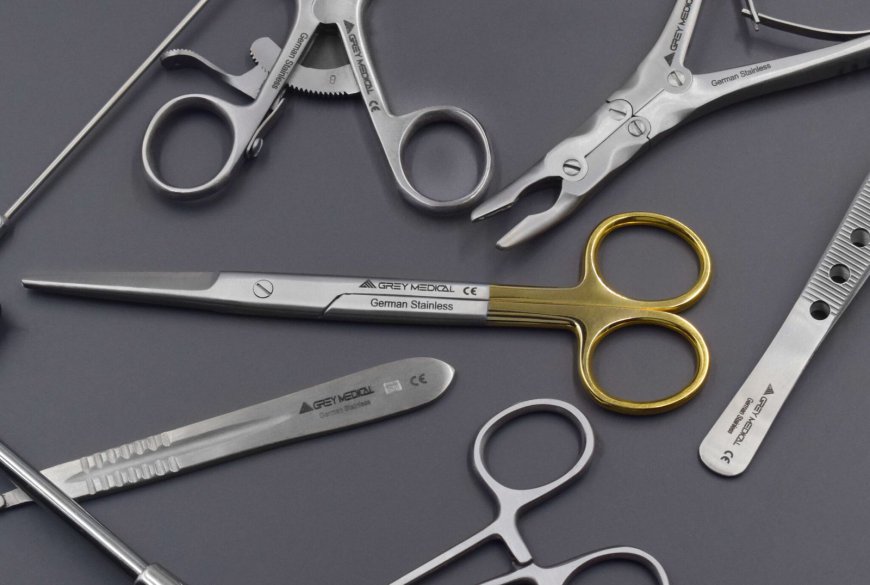Surgical Instruments: The Backbone of Successful Surgeries
Surgical Instruments
Introduction to Surgical Instruments
Surgical instruments are an essential part of every surgical procedure, designed to help surgeons perform tasks with precision and accuracy. These tools are vital for conducting safe and effective surgeries, as they aid in cutting, suturing, manipulating tissues, and controlling bleeding. The development of modern surgical instruments has revolutionized the way surgeries are performed, ensuring faster recovery times, fewer complications, and higher success rates. In addition to their functional roles, surgical instruments must also meet high standards of safety, durability, and sterility to reduce the risk of infection and other complications during and after surgery.

Categories of Surgical Instruments
Surgical instruments are classified according to their function within the procedure. Some of the most common types of surgical instruments include:
-
Cutting and Dissecting Instruments: These tools are used for making incisions, cutting tissues, and separating structures. Examples include scalpels, surgical scissors, bone saws, and lancets. Scalpels are most commonly used for making initial incisions, while scissors may be employed for cutting soft tissues, such as skin or muscle. Bone saws, used primarily in orthopedic procedures, allow surgeons to cut bone with precision.
-
Grasping and Holding Instruments: Grasping instruments, such as forceps and clamps, are used to hold tissues, blood vessels, or organs in place. They help provide better access and visibility during surgery. Forceps come in various types, such as tissue forceps for delicate tissues or hemostatic forceps for controlling blood vessels. Clamps, such as mosquito and Kelly clamps, are particularly useful for stopping bleeding by temporarily constricting blood vessels.
-
Suturing Instruments: Suturing is an essential part of many surgeries, and instruments designed for this task include needle holders, suture scissors, and suturing needles. Needle holders are used to securely grasp the needle while sewing tissues together, ensuring that the needle does not slip and that sutures are placed with accuracy.
-
Retractors: Retractors are used to hold back tissues, such as skin, muscle, or internal organs, to allow better access to the surgical site. There are various types of retractors, such as hand-held retractors, which require manual holding by the assistant, and self-retaining retractors, which can hold tissues back on their own without external support.
-
Electrosurgical Instruments: Electrosurgery tools, including cauterizing devices and electroscalpels, are used to cut, coagulate, or vaporize tissues through the use of electrical currents. These instruments are essential for stopping bleeding and making precise incisions in both soft and hard tissues.
-
Specialized Instruments: Some surgical procedures require specialized instruments designed for specific tasks, such as those used in neurosurgery, ophthalmic surgery, and orthopedic surgery. For example, neurosurgical forceps, brain reamers, and micro-scissors are used in delicate procedures involving the brain and spinal cord, while orthopedic surgical tools may include bone chisels, drills, and osteotomes for bone manipulation.
Material and Manufacturing of Surgical Instruments
Surgical instruments are typically made from high-quality materials such as stainless steel, titanium, or carbon fiber. Stainless steel is widely used due to its corrosion resistance, strength, and durability. Titanium is also popular in surgical instruments for its lightweight properties and resistance to corrosion, particularly in instruments that need to be both strong and light. Certain instruments may also feature tungsten carbide inserts for enhanced cutting capabilities, especially in scissors and needle holders.
The design and manufacture of surgical instruments involve precise craftsmanship. Manufacturers must ensure that the instruments are not only functional but also ergonomically designed to minimize hand fatigue and allow surgeons to work efficiently for extended periods. The manufacturing process also includes ensuring that the tools meet strict safety and quality standards, as any defect or malfunction could lead to complications during surgery.
Sterilization and Maintenance of Surgical Instruments
Due to the invasive nature of surgery, it is crucial that surgical instruments are sterile before use. Instruments are typically sterilized using autoclaves, which use steam under pressure to kill bacteria, viruses, and fungi. Sterilization procedures ensure that the instruments do not introduce infections into the surgical site.
After each use, instruments must be thoroughly cleaned, checked for signs of wear and tear, and sterilized before reuse. Regular inspection is vital to detect any damage, such as dull edges, cracks, or corrosion, which may compromise the instrument's functionality or safety. Proper storage of surgical instruments, such as in sterile containers, also plays a key role in maintaining their cleanliness and longevity.
Conclusion
Surgical instruments are vital to the success of any surgical procedure. With advancements in technology and materials, surgical tools have become more precise, reliable, and versatile, allowing surgeons to perform a wide range of procedures with greater ease and safety. The careful design, manufacturing, and maintenance of surgical instruments ensure that they meet the highest standards of performance and hygiene, ultimately contributing to improved patient outcomes. As medical science continues to advance, the role of surgical instruments in enhancing the precision and effectiveness of surgery will only become more significant.

 Greymedical
Greymedical